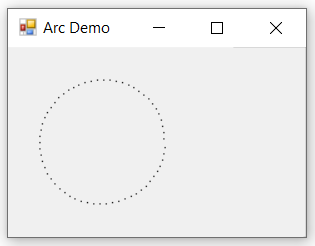Как рассчитать точку на окружности круга?
Как реализовать следующую функцию на разных языках?
Рассчитать (x,y) указать на окружности круга, учитывая входные значения:
- Радиус
- Угол
- Происхождение (необязательный параметр, если поддерживается языком)
6 ответов
Параметрическое уравнение для круга
x = cx + r * cos(a)
y = cy + r * sin(a)
Где r - радиус, cx, cy - начало координат и a угол.
Это довольно легко адаптировать к любому языку с помощью основных функций триггера. Обратите внимание, что большинство языков будут использовать радианы для угла в тригонометрических функциях, поэтому вместо циклического отклонения до 0,360 градуса вы будете циклически проходить через радианы с шагом 0,2 ПП.
Вот моя реализация в C#:
public static PointF PointOnCircle(float radius, float angleInDegrees, PointF origin)
{
// Convert from degrees to radians via multiplication by PI/180
float x = (float)(radius * Math.Cos(angleInDegrees * Math.PI / 180F)) + origin.X;
float y = (float)(radius * Math.Sin(angleInDegrees * Math.PI / 180F)) + origin.Y;
return new PointF(x, y);
}
Кому нужен триг, когда у вас есть комплексные числа:
#include <complex.h>
#include <math.h>
#define PI 3.14159265358979323846
typedef complex double Point;
Point point_on_circle ( double radius, double angle_in_degrees, Point centre )
{
return centre + radius * cexp ( PI * I * ( angle_in_degrees / 180.0 ) );
}
Реализовано на JavaScript (ES6):
/**
* Calculate x and y in circle's circumference
* @param {Object} input - The input parameters
* @param {number} input.radius - The circle's radius
* @param {number} input.angle - The angle in degrees
* @param {number} input.cx - The circle's origin x
* @param {number} input.cy - The circle's origin y
* @returns {Array[number,number]} The calculated x and y
*/
function pointsOnCircle({ radius, angle, cx, cy }){
angle = angle * ( Math.PI / 180 ); // Convert from Degrees to Radians
const x = cx + radius * Math.cos(angle);
const y = cy + radius * Math.sin(angle);
return [ x, y ];
}
Применение:
const [ x, y ] = pointsOnCircle({ radius: 100, angle: 180, cx: 150, cy: 150 });
console.log( x, y );
/**
* Calculate x and y in circle's circumference
* @param {Object} input - The input parameters
* @param {number} input.radius - The circle's radius
* @param {number} input.angle - The angle in degrees
* @param {number} input.cx - The circle's origin x
* @param {number} input.cy - The circle's origin y
* @returns {Array[number,number]} The calculated x and y
*/
function pointsOnCircle({ radius, angle, cx, cy }){
angle = angle * ( Math.PI / 180 ); // Convert from Degrees to Radians
const x = cx + radius * Math.cos(angle);
const y = cy + radius * Math.sin(angle);
return [ x, y ];
}
const canvas = document.querySelector("canvas");
const ctx = canvas.getContext("2d");
function draw( x, y ){
ctx.clearRect( 0, 0, canvas.width, canvas.height );
ctx.beginPath();
ctx.strokeStyle = "orange";
ctx.arc( 100, 100, 80, 0, 2 * Math.PI);
ctx.lineWidth = 3;
ctx.stroke();
ctx.closePath();
ctx.beginPath();
ctx.fillStyle = "indigo";
ctx.arc( x, y, 6, 0, 2 * Math.PI);
ctx.fill();
ctx.closePath();
}
let angle = 0; // In degrees
setInterval(function(){
const [ x, y ] = pointsOnCircle({ radius: 80, angle: angle++, cx: 100, cy: 100 });
console.log( x, y );
draw( x, y );
document.querySelector("#degrees").innerHTML = angle + "°";
document.querySelector("#points").textContent = x.toFixed() + "," + y.toFixed();
}, 100 );<p>Degrees: <span id="degrees">0</span></p>
<p>Points on Circle (x,y): <span id="points">0,0</span></p>
<canvas width="200" height="200" style="border: 1px solid"></canvas>Расчет точки на окружности круга с учетом пройденного расстояния.
Для сравнения ... Это может быть полезно в Game AI при движении вокруг твердого объекта по прямому пути.
public static Point DestinationCoordinatesArc(Int32 startingPointX, Int32 startingPointY,
Int32 circleOriginX, Int32 circleOriginY, float distanceToMove,
ClockDirection clockDirection, float radius)
{
// Note: distanceToMove and radius parameters are float type to avoid integer division
// which will discard remainder
var theta = (distanceToMove / radius) * (clockDirection == ClockDirection.Clockwise ? 1 : -1);
var destinationX = circleOriginX + (startingPointX - circleOriginX) * Math.Cos(theta) - (startingPointY - circleOriginY) * Math.Sin(theta);
var destinationY = circleOriginY + (startingPointX - circleOriginX) * Math.Sin(theta) + (startingPointY - circleOriginY) * Math.Cos(theta);
// Round to avoid integer conversion truncation
return new Point((Int32)Math.Round(destinationX), (Int32)Math.Round(destinationY));
}
/// <summary>
/// Possible clock directions.
/// </summary>
public enum ClockDirection
{
[Description("Time moving forwards.")]
Clockwise,
[Description("Time moving moving backwards.")]
CounterClockwise
}
private void ButtonArcDemo_Click(object sender, EventArgs e)
{
Brush aBrush = (Brush)Brushes.Black;
Graphics g = this.CreateGraphics();
var startingPointX = 125;
var startingPointY = 75;
for (var count = 0; count < 62; count++)
{
var point = DestinationCoordinatesArc(
startingPointX: startingPointX, startingPointY: startingPointY,
circleOriginX: 75, circleOriginY: 75,
distanceToMove: 5,
clockDirection: ClockDirection.Clockwise, radius: 50);
g.FillRectangle(aBrush, point.X, point.Y, 1, 1);
startingPointX = point.X;
startingPointY = point.Y;
// Pause to visually observe/confirm clock direction
System.Threading.Thread.Sleep(35);
Debug.WriteLine($"DestinationCoordinatesArc({point.X}, {point.Y}");
}
}
int x = (int)(radius * Math.Cos(degree * Math.PI / 180F)) + cCenterX;
int y = (int)(radius * Math.Sin(degree * Math.PI / 180F)) + cCenterY;
The
cCenterXа также
cCenterYявляются центральной точкой окружности
